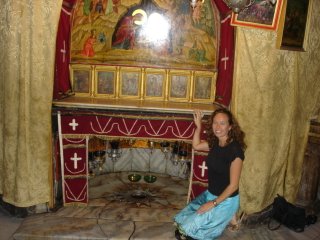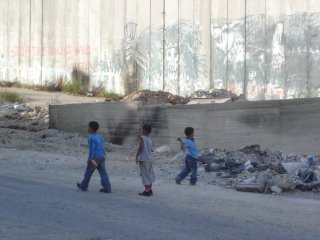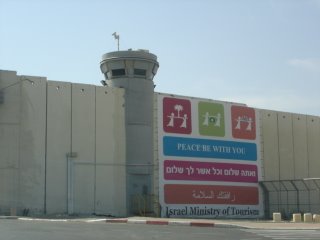




This weekend I went with three fellow students to Bethlehem and Hebron on a tour that is part a growing industry in Palestine--"occupation tourism". There is a non-profit organization/travel agency that specializes in showing visitors the devastating effects of the Israeli occupation on the life of Palestinians. One of our group has a car so he picked us up outside the checkpoint into Jerusalem and we drove together into Bethlehem. After getting lost for a few minutes trying to find the entrance into Bethlehem (which is completely surrounded by a gigantic wall,) we finally found it, graced by what we thought the most oxymoronic welcome--an enormous "Peace be with you" sign by the Israeli Ministry of Tourism. (see picture)
We met up with our guide, and dropped our bags off at the Arab Women’s Union hostel in the town of Bet Sahor, a primarily Christian town next to Bethlehem. Our guide said Bethlehem is about 80% Muslim, but Bet Sahor is about 80% Christian.
We first visited an NGO promoting bridge-building activities between Israelis and Palestinians as well as comprehensive news coverage on their related website, http://www.imemc.org/ Check it out for constantly updated news about Israel/Palestine. They seemed a bit downtrodden; the director, a Palestinian christian, admitted he was “very tired” with the whole situation and lamented that the more you know about the situation and the more you try to take it on, the more tiring it is.
As our positive highlight of the day, we visited the Church of the Nativity where Jesus was born. Interestingly enough, the “stable” we think of where he was born is actually a cave below the altar, and a star with 14 points on it marks the spot where he was born (14 for the 14 stations Jesus stopped on while he carried the cross as well as the 14 generations from David) . A separate shrine marks the spot where Mary laid Jesus in the manger. The church is the oldest in the region, from 300 something AD and was not destroyed by the Persian invaders in ?? year, like every other structure was in Bethlehem. Our guide said the Persians didn't destroy the church because they saw a mosaic on the outside of the church of the 3 wisemen in Persian dress and thought that there must be Persians who live or worship there. Just like the Church of the Holy Sepulchre in Jerusalem where Jesus died, the church is divided into three sectors, the Greek Orthodox, Armenian, and Catholic church. Each year around Christmas the different sects celebrate Jesus’ birthday on a different day. 24 December Mass, for example, is held in the Catholic part of the church only.
After the church, we got a tour of a refugee camp in Bethlehem, located right next to the wall that surrounds Bethlehem. We heard their stories of the wall being built and cutting them off from the olive trees, fields, and playgrounds that were right next to the camp. We saw the zig-zag of the wall that was designed to close Bethlehem in as tightly as possible and take as much land as possible from the area. We could also see a huge Israeli settlement close to Bethlehem, an area packed so tightly with apartments, it looked like a block of legos. They showed us pictures of what it used to look like—a mountain covered with forest (the only forest in the area) and belonging to the Arab Abu Gheinem family. There is now not one tree on the entire huge hill, so covered it is with apartments.
The night we spent in Bet Sahor was very low-key. After a small dinner, we walked around the beatiful old city with cobble-stone streets. It was a shock to see women walking around in low-cut and sleeveless tops and shorter pants and not a hijab in sight. You could definitely tell the town was Christian! Also men and women mingling together, which is a rare sight in the West Bank. Back home to get ready for the next adventure!

No comments:
Post a Comment